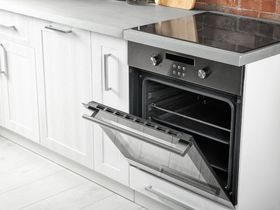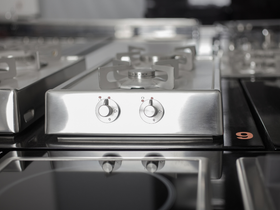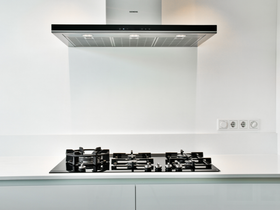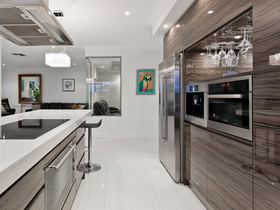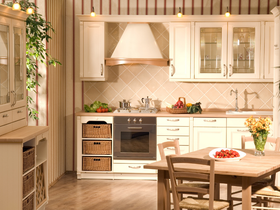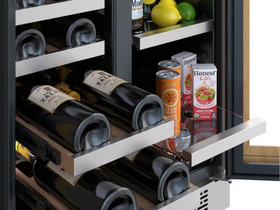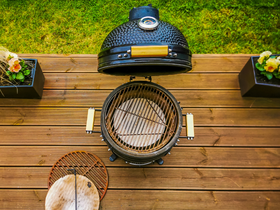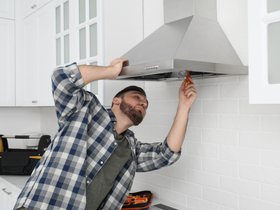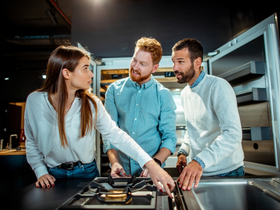What’s the difference between a freestanding and a slide-in range?
Freestanding ranges have finished sides and a backguard, allowing them to be placed anywhere in the kitchen. Slide-in ranges are designed to fit between cabinets for a seamless, built-in look and typically have front-mounted controls with no backguard. If you're doing a remodel or want a cleaner aesthetic with your backsplash, a slide-in range is ideal. If you're replacing an old unit without changing cabinets, freestanding is more flexible.
Gas, electric, or dual-fuel — which type is best?
Each fuel type has its benefits. Gas offers quick, responsive heat and is preferred by many cooks for stovetop use. Electric provides even oven heating and smooth cooktops that are easier to clean. Dual-fuel ranges combine a gas cooktop with an electric oven for the best of both worlds. Choose based on your cooking habits, energy setup, and whether you prioritize stovetop or baking performance.
What size range should I buy?
The most common range widths are 30", 36", 48", and 60". A 30" range suits most homes, while 36" or larger sizes are better for serious cooks or entertainers. Consider your kitchen space, how many burners you need, and whether a double oven or griddle zone is important. Always measure your cabinet opening and check appliance specs before purchasing.
How much ventilation do I need for my range?
Ventilation depends on your range's size and BTU output. A good rule is 100 CFM (cubic feet per minute) of ventilation per 10 inches of range width. Gas ranges or ranges with high BTU burners may need more. For instance, a 36" gas range might need a 600+ CFM hood. Proper ducting, installation height, and clearance are critical for performance.
What’s the difference between convection and conventional ovens?
Convection ovens use a fan to circulate hot air, resulting in even temperatures and faster cooking. This is ideal for baking multiple trays or roasting evenly. Conventional ovens rely on radiant heat from the top and bottom, which can cause uneven results. Many modern ovens let you toggle between the two, offering versatility depending on your recipe.
Are induction ranges better than gas or electric?
Induction ranges heat cookware directly using magnetic fields, which makes them extremely fast and efficient. They’re safer (cooktop stays cooler) and often easier to clean. However, they require induction-compatible cookware (ferrous metals like cast iron or some stainless steels). They’re excellent for households prioritizing speed, safety, and energy efficiency.
Do I need a range hood if my range has a downdraft system?
Downdraft systems are built into some ranges and pull air downward. They’re useful in island setups or when overhead ventilation isn’t possible. However, they are generally less powerful than overhead range hoods. If you cook frequently or use high-heat methods, an overhead hood typically offers better airflow and grease capture.
What features should I look for in a high-end range?
Key features to look for include: multiple burner sizes and BTUs, dual ovens or warming drawers, true convection baking, high-CFM ventilation compatibility, smart connectivity (WiFi control, diagnostics), self-cleaning cycles, and durable, easy-to-clean finishes. Think about what will enhance your cooking and cleaning experience.
Is a double oven range worth it?
Double oven ranges are ideal for multitasking — baking at two temperatures or keeping one dish warm while cooking another. They’re great for families, entertainers, and holiday cooks. The trade-off is that individual oven cavities are smaller than in a single large oven, so consider the size of your cookware.
How do I know if a range will fit my existing kitchen space?
Always measure the width, height, and depth of your existing cutout. Account for door clearance, back wall obstructions (like gas hookups or outlets), and whether adjacent counters or cabinets will interfere with opening the oven door. Don’t forget vertical clearance for ventilation.
Can I install a range myself or should I hire a professional?
Electric ranges can sometimes be DIY-installed if the proper outlet is already in place. Gas ranges, however, should always be installed by a licensed professional to ensure safety and code compliance. Slide-in or built-in units may require countertop or cabinetry adjustments, so consult with a contractor or installer if you're unsure.
What’s the benefit of sealed burners vs. open burners?
Sealed burners have a cap over the flame, which keeps spills and debris from entering the burner box. They’re easier to clean and are standard in most residential ranges. Open burners, common in commercial ranges, offer better heat distribution and faster response but are harder to clean.
How do smart ranges work?
Smart ranges connect to Wi-Fi or Bluetooth, allowing remote control of oven settings, timers, and diagnostics via an app. Some models integrate with voice assistants like Alexa or Google Home. They can alert you when preheating is done or if there’s a maintenance issue. This tech is helpful for multitasking or managing cooking remotely.
What kind of cookware works best with different cooktops?
Gas: Works with all cookware types. Choose heavy-bottomed pans for even heat.
Electric: Flat-bottomed cookware ensures full contact on smooth-top ranges.
Induction: Requires ferrous metal cookware (magnetic). If a magnet sticks to the bottom, it works.
How do self-cleaning ovens work — and are they safe to use?
Self-cleaning ovens use high heat (800°F+) to incinerate food residue into ash, which you can wipe out afterward. Some models use steam to loosen debris at lower temps. While safe if used correctly, self-cleaning cycles can produce strong odors and heat. Always remove racks (unless specified), ventilate your kitchen, and follow the manufacturer’s guidelines.


